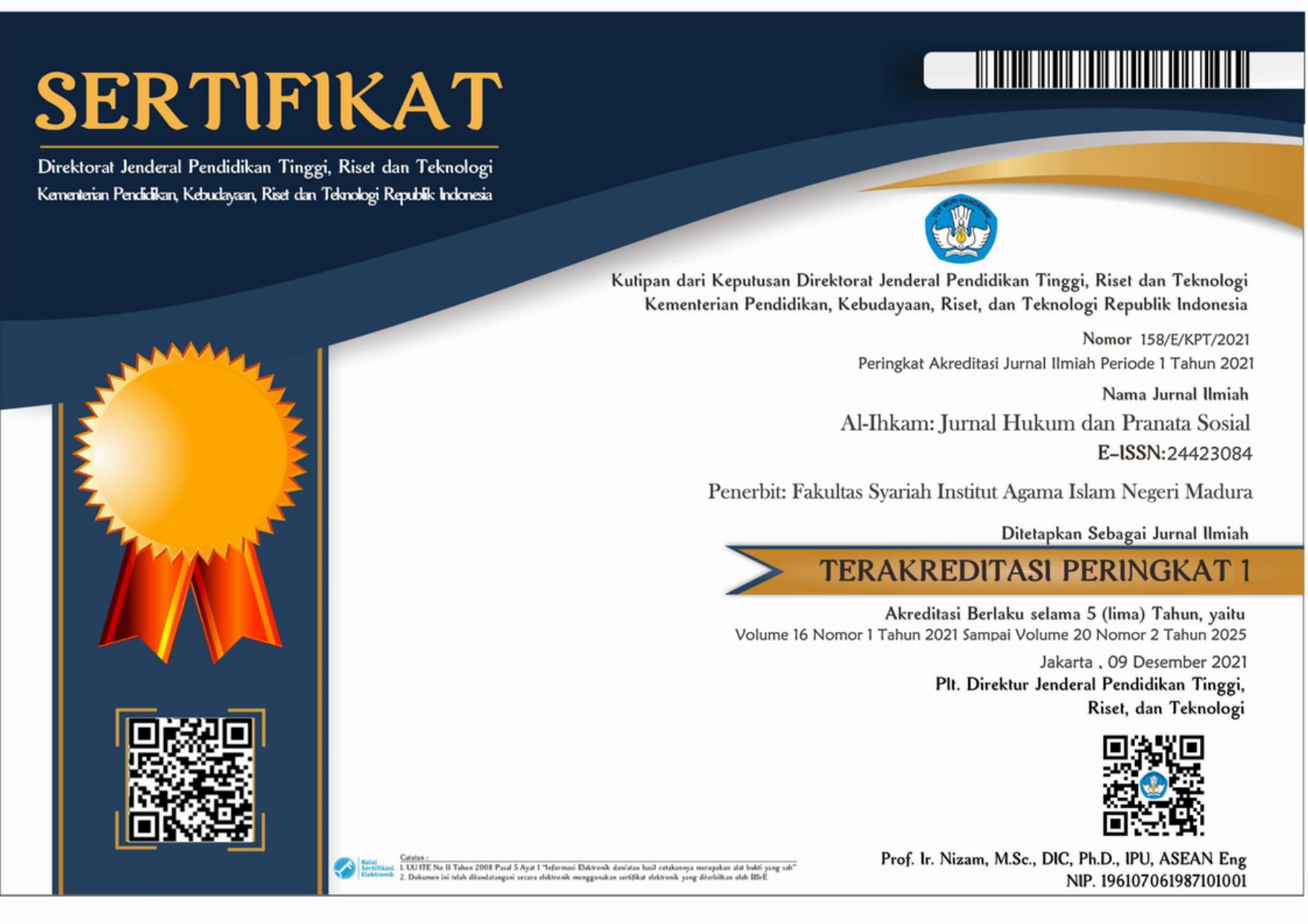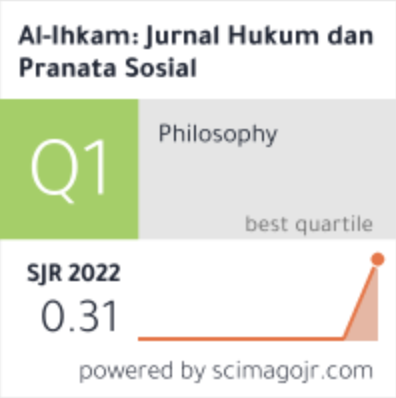The Interplay of Fiqh, Adat, and State Marriage Law: Shaping Legal Consciousness of Sasak Women
 Abstract views: 558
,
Abstract views: 558
,
 PDF downloads: 578
PDF downloads: 578
Abstract
Sasak women grapple with a legal conundrum stemming from the coexistence of multiple marriage legal frameworks encompassing fiqh, adat, and state law. This intricate legal pluralism dynamically shapes the legal consciousness of Sasak women as they navigate the selection of legal avenues to secure legality and address their marital legal challenges. This study pursues two primary objectives: firstly, to examine the intricate interplay among fiqh, adat, and state marriage law concerning the provision of legal certainty and protection for Sasak women; secondly, to probe into the manifestations of legal consciousness arising from the plural marriage legal frameworks. Data were collected through document analysis, literature review, and in-depth interviews with selected Sasak women. The findings illuminate a dynamic interplay among fiqh, adat, and state marriage law across various marital facets, including prenuptial considerations, minimum marriage age, marriage prerequisites and pillars, marriage contracts, residency, polygamy, divorce, and reconciliation. Moreover, the study identifies three distinct forms of legal consciousness emerging among Sasak women: ‘before the law’ when confronting fiqh, ‘with the law’ when embracing formal legal mechanisms to address marital issues, and ‘against the law’ when eschewing formal legal provisions. In conclusion, state marriage laws are more progressive in providing legal certainty and protection for women but lacking criminal sanctions/fines weakens their position compared to religious law (fiqh) and customs (adat). Ultimately, this shapes the legal consciousness of Sasak women in diverse ways.
Downloads
References
Alkhanif. “Women, Islam, and Modern Family Construction in the Perspectives of Legal Pluralism in Indonesia.” PETITA: Jurnal Kajian Ilmu Hukum dan Syariah 4, no. 2 (2019). https://doi.org/10.22373/petita.v4i2.24.
Amin, Ibnu, Lendrawati, Faisal Efendi, and Hertasmaldi. “The Concept of Baligh Perspective of Fiqh and Positive Law.” Al-Istinbath: Jurnal Hukum Islam 7, no. 2 (2022): 441–66. https://doi.org/10.29240/jhi.v7i2.5268.
Asmara, Musda, and Reti Andira. “Urgensi Talak di Depan Sidang Pengadilan Perspektif Maslahah Mursalah.” Al-Istinbath : Jurnal Hukum Islam 3, no. 2 (2018): 207. https://doi.org/10.29240/jhi.v3i2.626.
Chua, Lynette J, and David M Engel. “Legal Consciousness Reconsidered.” Annual Review of Law and Social Science 15, no. 1 (2019): 335–53. https://doi.org/10.1146/annurev-lawsocsci-101518-042717.
Dedi, Syarial. “Ushul Fiqih Menurut Paradigma Filsafat Ilmu (Kajian Ontologi, Epistemologi, dan Aksiologi).” Al-Istinbath: Jurnal Hukum Islam 5, no. 2 (2020): 289–310. https://doi.org/10.29240/jhi.v5i2.1829.
Djawas, Mursyid, Hedhri Nadhiran, Sri Astuti A. Samad, Zahrul Mubarrak, and Muhammad Abrar Azizi. “Creating Family Resilience in Indonesia: A Study of ‘Marriage Guidance’ Program in Aceh and South Sumatera.” Al-Ihkam: Jurnal Hukum dan Pranata Sosial 17, no. 1 (2022). https://doi.org/10.19105/AL-LHKAM.V17I1.6150.
Ewick, P., and Silbey. S. The Common Place of Law: Stories From Everyday Life. University of Chicago Press, 1998.
Fahriyanti, Nurmala. “Gugat Cerai: Membebaskan Prempuan Dari Penderitaan.” QAWWAM 13, no. 2 (2019): 101–22. https://doi.org/10.20414/qawwam.v13i2.1468.
Faiz, Muhammad Fauzinudin, Zezen Zainul Ali, and Muhammad Taufiq. “Underage Widows and Widowers before the Law: Problem, Contestation and Legal Certainty in Marriage Dispensation.” Juris: Jurnal Ilmiah Syariah 22, no. 2 (2023): 223–34. https://doi.org/10.31958/juris.v22i2.9097.
Flambonita, Suci. “The Concept of Legal Pluralism in Indonesia in the New Social Movement.” Jurnal Analisa Sosiologi 10, no. 3 (2021). https://doi.org/10.20961/jas.v10i0.45939.
Halliday, Simon, Celia Kitzinger, and Jenny Kitzinger. “Law in Everyday Life and Death: A Socio-Legal Study of Chronic Disorders of Consciousness.” Legal Studies 35, no. 1 (2015): 55–74. https://doi.org/10.1111/lest.12042.
Horák, Filip, David Lacko, and Adam Klocek. “Legal Consciousness: A Systematic Review of Its Conceptualization and Measurement Methods1.” Anuario de Psicologia Juridica 31, no. 1 (2021): 9–34. https://doi.org/10.5093/APJ2021A2.
Indonesia, Republik. UU No. 1 Tahun 1974 tentang Perkawinan (1974).
Liu, Qian. “Legal Consciousness of the Leftover Woman: Law and Qing in Chinese Family Relations.” Asian Journal of Law and Society 5, no. 1 (2018): 7–27. https://doi.org/10.1017/als.2017.28.
Menchik, Jeremy. “The Co-Evolution of Sacred and Secular: Islamic Law and Family Planning in Indonesia.” South East Asia Research 22, no. 3 (2014): 359–78. https://doi.org/10.5367/sear.2014.0220.
Moustafa, Tamir. “Islamic Law, Women’s Rights, and Popular Legal Consciousness in Malaysia.” Law and Social Inquiry 38, no. 1 (2013): 168–88. https://doi.org/10.1111/j.1747-4469.2012.01298.x.
Munir, Zainal Arifin Haji. “Wealth Distribution among Sasak Communities Through Inheritance: A Quest for Justice.” Samarah 7, no. 3 (2023): 1627–43. https://doi.org/10.22373/sjhk.v7i3.10835.
Mursyid, Salmah, and Nasruddin Yusuf. “Changes in Marriage Age Limits and Marriage Dispensations: A Study of Causes and Impacts on the Religious Courts in North Sulawesi.” Samarah 6, no. 2 (2022): 975–96. https://doi.org/10.22373/sjhk.v6i2.12439.
Mutaqin, Zezen Zaenal. “Culture, Islamic Feminism, and the Quest for Legal Reform in Indonesia.” Asian Journal of Women’s Studies 24, no. 4 (2018): 423–45. https://doi.org/10.1080/12259276.2018.1524549.
Nasir, Mohamad Abdun. “Islamic Law and Paradox of Domination and Resistance: Women’s Judicial Divorce in Lombok, Indonesia.” Asian Journal of Social Science 44, no. 1–2 (2016). https://doi.org/10.1163/15685314-04401006.
———. “Negotiating Muslim Interfaith Marriage in Indonesia: Integration and Conflict in Islamic Law.” Mazahib Jurnal Pemikiran Hukum Islam 21, no. 2 (2022): 155–86. https://doi.org/10.21093/mj.v21i2.5436.
Nimah, Zulfatun. “The Violation on Women’s Rights in the Unilateral Divorce in Sasak Community from A Feminist Legal Theory.” AL-IHKAM: Jurnal Hukum & Pranata Sosial 13, no. 1 (2018): 25–48. https://doi.org/10.19105/al-lhkam.v13i1.1482.
Nisa, Eva. “The Bureaucratization of Muslim Marriage in Indonesia.” Journal of Law and Religion 33 (2018): 1–19. https://doi.org/10.1017/jlr.2018.28.
Nurlaelawati, Euis. “Muslim Women in Indonesian Religious Courts: Reform, Strategies, and Pronouncement of Divorce.” Islamic Law and Society 20, no. 3 (2013): 242–71. https://doi.org/10.1163/15685195-0010A0003.
———. “Pernikahan Tanpa Pencatatan: Isbat Nikah Sebuah Solusi?” Musãwa Jurnal Studi Gender dan Islam 12, no. 2 (2013): 261. https://doi.org/10.14421/musawa.2013.122.261-277.
Platt, Maria. “‘It’s Already Gone Too Far’: Women and the Transition into Marriage in Lombok, Indonesia.” The Asia Pacific Journal of Anthropology 13, no. 1 (2012): 76–90. https://doi.org/10.1080/14442213.2011.636063.
———. Marriage, Gender and Islam in Indonesia: Women Negotiating Informal Marriage, Divorce and Desire. Marriage, Gender and Islam in Indonesia: Women Negotiating Informal Marriage, Divorce and Desire, 2017. https://doi.org/10.4324/9781315178943.
Rahiem, Maila D.H. “Covid-19 and the Surge of Child Marriages: A Phenomenon in Nusa Tenggara Barat, Indonesia.” Child Abuse and Neglect 118, no. Query date: 2023-05-20 16:53:02 (2021). https://doi.org/10.1016/j.chiabu.2021.105168.
Salim, Arskal. Contemporary Islamic Law in Indonesia: Sharia and Legal Pluralism. Contemporary Islamic Law in Indonesia: Sharia and Legal Pluralism. Vol. 6, 2015. https://doi.org/10.1080/14442213.2015.1125772.
Salma, Hasanatul Wahida, and Muhammad Adib Bin Samsudin. “Ignoring Family Law Administrative Procedure: Falsifying Death of Spouses for the Registration of New Marriage in Lengayang Muslim Community.” Al-Ahwal 15, no. 1 (2022): 1–20. https://doi.org/10.14421/ahwal.2022.15101.
Sari, Widya, Muhammad Arif, and Elkhairati. “Pemikiran Ibrahim Hosen tentang Konsep Pernikahan dan Kontribusinya Terhadap Pembaruan Hukum Perkawinan di Indonesia.” Al-Istinbath: Jurnal Hukum Islam 6, no. 1 (2021): 127–44. https://doi.org/10.29240/jhi.v6i1.2540.
Sarmini, Ulin Nadiroh, and Muhammad Saeun Fahmi. “Reduce Conflicts in Traditional Merariq Traditions through the Long Tradition of the Tribal People of Sasak Lombok.” Journal of Physics: Conference Series 953, no. 1 (2018): 012186. https://doi.org/10.1088/1742-6596/953/1/012186.
Smith, B., and Atun Wardatun. “Domestic Violence and Islamic Spirituality in Lombok, Indonesia: Women’s Use of Sufi Approaches to Suffering.” Contemporary Islam 16, no. 2–3 (2022). https://doi.org/10.1007/s11562-022-00495-5.
Smith, Bianca J. “Stealing Women, Stealing Men: Co-Creating Cultures of Polygamy in a Pesantren Community in Eastern Indonesia.” Journal of International Women’s Studies 15, no. 1 (2014): 118–35. https://vc.bridgew.edu/jiws/vol15/iss1/8/.
Sodiq, Muhammad. “Dualisme Hukum di Indonesia: Kajian tentang Peraturan Pencatatan Nikah dalam Perundang-Undangan.” Al-Ahwal: Jurnal Hukum Keluarga Islam 7, no. 2 (2016): 109. https://doi.org/10.14421/ahwal.2014.07201.
Sugitanata, Arif, Siti Aminah, Heru Sunardi, and Siti Khamidatus Sholikhah. “Violation of Women’s Rights: The Kawin Magrib Tradition of the Sasak Muslim Community in Lombok, Indonesia.” Journal of Islamic Law 4, no. 2 (2023). https://doi.org/10.24260/jil.v4i2.1772.
Syafruddin. Perlawanan Perempuan Sasak: Perspektif Femenisme. Mataram: Mataram University Press, 2007.
Syafruddin, Ulfatun Hasanah, Imam Malik, and Ananda Wahidah. “One-Party Divorce: The Devaluation of Sasak Women in Eastern Indonesia.” Przestrzen Spoleczna 22, no. 3 (2022): 114–32.
Wahid, Abdul, and Atun Wardatun. “Listening to Everyone’s Voice: The Contested Rights of Muslim Marriage Practices in Eastern Indonesia.” Global Journal Al-Thaqafah 10, no. 2 (2020): 47–57. https://doi.org/10.7187/gjat122020-6.
Wardatun, Atun, and Bianca J. Smith. “Woman-Initiated Divorce and Feminist Fiqh in Indonesia: Narrating Male Acts of Nushūz in Marriage.” Ulumuna 24, no. 2 (2020). https://doi.org/10.20414/ujis.v24i2.416.
Wirastri, Theresia Dyah, and Stijn Cornelis van Huis. “The Second Wife: Ambivalences towards State Regulation of Polygamy in Indonesia.” The Journal of Legal Pluralism and Unofficial Law 53, no. 2 (2021): 246–68. https://doi.org/10.1080/07329113.2021.1912579.
Yuliandri, Zainul Daulay, Saldi Isra, Kurnia Warman, and Hilaire Tegnan. “Shifting from Legal Pluralism to Legal Syncretism in Multi-Cultural Indonesia.” ISVS E-Journal 10, no. 1 (2023): 182–92.
Copyright (c) 2024 AL-IHKAM: Jurnal Hukum & Pranata Sosial

This work is licensed under a Creative Commons Attribution-ShareAlike 4.0 International License.
In order to be accepted and published by Al-Ihkam: Jurnal Hukum dan Pranata Sosial, author(s) submitting the article manuscript should complete all the review stages. By submitting the manuscript, the author(s) agreed to the following terms:
- The copyright of received articles shall be assigned to Al-Ihkam: Jurnal Hukum dan Pranata Sosial as the publisher of the journal. The intended copyright includes the right to publish articles in various forms (including reprints). Al-Ihkam: Jurnal Hukum dan Pranata Sosial maintain the publishing rights to the published articles.
- Authors are permitted to disseminate published articles by sharing the link/DOI of the article at Al-Ihkam: Jurnal Hukum dan Pranata Sosial. Authors are allowed to use their articles for any legal purposes deemed necessary without written permission from Al-Ihkam: Jurnal Hukum dan Pranata Sosial with an acknowledgment of initial publication to this journal.
- Users/public use of this website will be licensed to CC-BY-SA.



.png)
_1.png)










